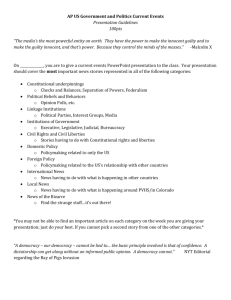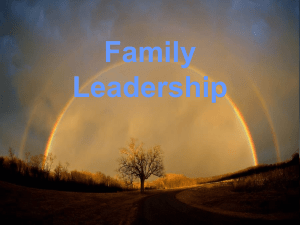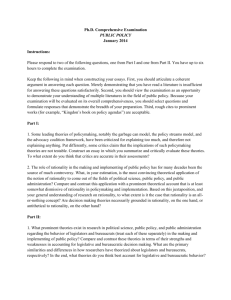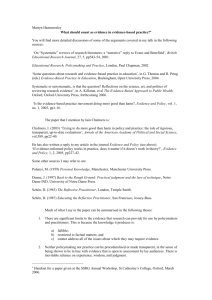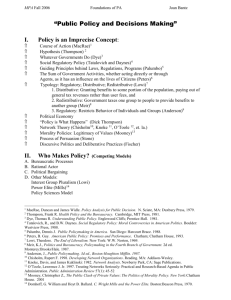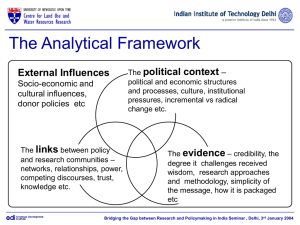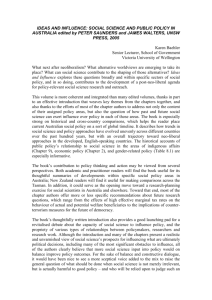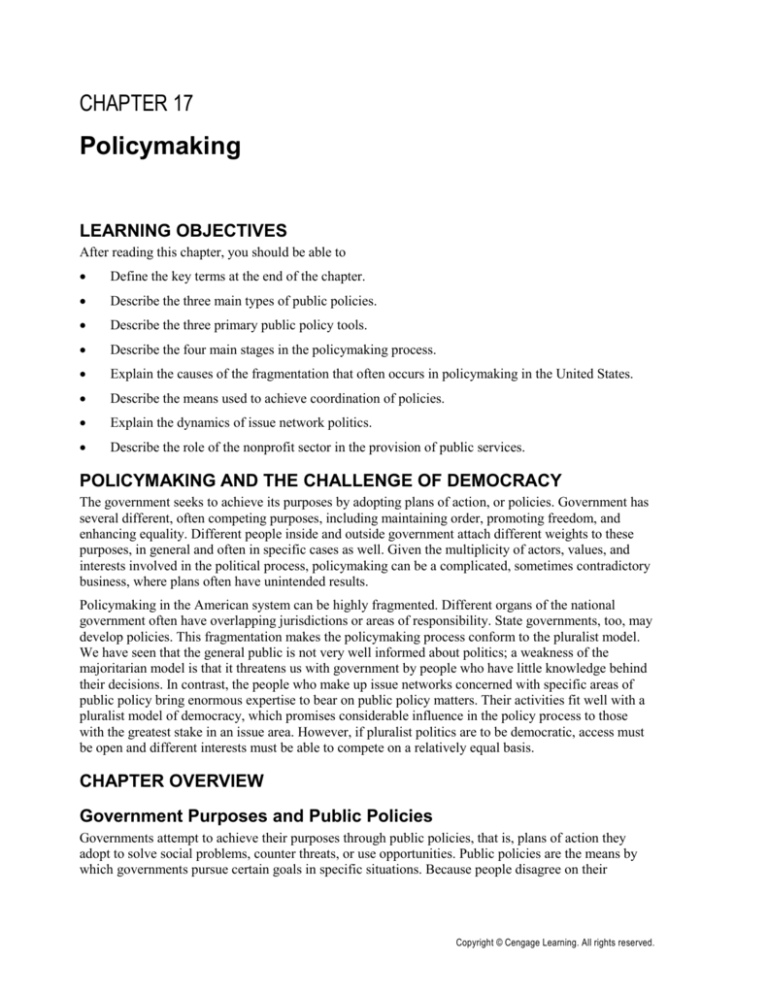
CHAPTER 17
Policymaking
LEARNING OBJECTIVES
After reading this chapter, you should be able to
Define the key terms at the end of the chapter.
Describe the three main types of public policies.
Describe the three primary public policy tools.
Describe the four main stages in the policymaking process.
Explain the causes of the fragmentation that often occurs in policymaking in the United States.
Describe the means used to achieve coordination of policies.
Explain the dynamics of issue network politics.
Describe the role of the nonprofit sector in the provision of public services.
POLICYMAKING AND THE CHALLENGE OF DEMOCRACY
The government seeks to achieve its purposes by adopting plans of action, or policies. Government has
several different, often competing purposes, including maintaining order, promoting freedom, and
enhancing equality. Different people inside and outside government attach different weights to these
purposes, in general and often in specific cases as well. Given the multiplicity of actors, values, and
interests involved in the political process, policymaking can be a complicated, sometimes contradictory
business, where plans often have unintended results.
Policymaking in the American system can be highly fragmented. Different organs of the national
government often have overlapping jurisdictions or areas of responsibility. State governments, too, may
develop policies. This fragmentation makes the policymaking process conform to the pluralist model.
We have seen that the general public is not very well informed about politics; a weakness of the
majoritarian model is that it threatens us with government by people who have little knowledge behind
their decisions. In contrast, the people who make up issue networks concerned with specific areas of
public policy bring enormous expertise to bear on public policy matters. Their activities fit well with a
pluralist model of democracy, which promises considerable influence in the policy process to those
with the greatest stake in an issue area. However, if pluralist politics are to be democratic, access must
be open and different interests must be able to compete on a relatively equal basis.
CHAPTER OVERVIEW
Government Purposes and Public Policies
Governments attempt to achieve their purposes through public policies, that is, plans of action they
adopt to solve social problems, counter threats, or use opportunities. Public policies are the means by
which governments pursue certain goals in specific situations. Because people disagree on their
Copyright © Cengage Learning. All rights reserved.
Chapter 17: Policymaking
167
perceptions of situations and on the appropriateness of goals and means, they differ on which public
policies should be created, adopted, interpreted, and changed.
The Policymaking Process
Policy choices may involve clashes between the competing values of freedom, order, and equality. The
problem of illegal drug use pits advocates of legalization (proponents of freedom) against those who
favor harsh penalties for drug use (proponents of order) and against those who favor treatment for drug
addiction (proponents of equality). Currently, our government provides lots of penalties and some
treatment, but there is no talk of legalization.
Public policies take one of three basic forms. Distributive policies provide a particular benefit or service
to particular groups. Redistributional policies take resources from one sector of society and give them
to another. Regulatory policies spell out the rules that guide government programs. Whatever the policy
objectives of government, the main arsenal of tools are incentives and disincentives, direct provision of
services, and rule setting. They are often combined to achieve a particular goal, and over time one
approach may fall out of favor and another may be tried. Policies aimed at specific problems are not
static; means, goals, and situations change. Public policies are typically reviewed and updated in stages.
An agenda setting stage, in which a problem is defined as a political problem
A policy formulation stage, in which possible solutions are developed in the form of policy
proposals and decisions are made about which proposal (if any) to adopt
An implementation stage, in which a policy is carried out (often amid difficulties in coordinating
the activities of government officials at various levels, who must implement the policy)
A policy evaluation stage, in which programs are analyzed to discover how well they work in
practice
Evaluation results in feedback, that is, information that lets policymakers know how well programs are
doing what they were created to do. Feedback information can be used to decide whether the programs
should be continued, expanded, changed, or cut or whether new items should be put on the political
agenda, and, hence, to a new cycle of policymaking.
Fragmentation and Coordination
The fundamental nature of U.S. government—federalism and the separation of powers—contributes to
the fragmentation of policymaking by creating multiple centers of power. These centers of power may
pursue competing policies in the same policy area. This circumstance may be the result of real conflict
between branches of government or merely a lack of coordination within a branch. Sometimes,
problems of fragmentation and coordination may be attacked by reassignment of agency jurisdictions,
by reform of congressional committees, by Office of Management and Budget regulatory review, or by
industry appeals for a single national policy to replace fifty state policies in an issue area.
In any given issue area, many interest groups try to influence policy. These private sector actors are
effective when they are able to provide technical mastery of a policy area. In Washington, D.C., U.S.
government often amounts to government by policy area, which involves interaction among various
government institutions and private sector organizations. When changes in the Clean Air Act were
considered, for example, a group of actors emerged with shared knowledge of this aspect of
environmental policy, including members of Congress, EPA bureaucrats, consultants, lawyers
representing environmentalists, lawyers representing industries, and public relations firms representing
trade associations and trying to sway public opinion. These actors, who share a knowledge of and an
interest in the particular policy under consideration, form an issue network.
Copyright © Cengage Learning. All rights reserved.
168
Chapter 17: Policymaking
Recently, the concept of issue networks has emerged to describe the policymaking process. Issue
networks include a large and varied group of participants and are more easily penetrated than iron
triangles (although they are still held together by technical mastery of particular policy areas).
Individuals in an issue network speak the same language; they are united by shared knowledge of and
experience in a policy area. Although it is desirable to have those with expertise influence
policymaking, the dominance of iron triangles and issue networks in the process may make
policymaking appear too responsive to the demands of small groups and hence undemocratic.
The Nonprofit Sector
Community-based organizations have become important players in the policymaking process.
Nonprofits are voluntary organizations that use government funds to implement a government program.
They provide vitally important services and tap into a large pool of volunteer labor. It is estimated that
over 100 million Americans volunteer on a regular basis. According to one scholar, they are “the glue
that holds civil society together.”
KEY TERMS
public policy
distributive policies
redistributional policies
regulation
agenda setting
issue definition
policy formulation
implementation
policy evaluation
feedback
fragmentation
issue network
nonprofit organization
RESEARCH AND RESOURCES
Who makes up issue networks? Who influences policymaking? What are their names? For whom do
they work? If you are interested in finding answers to questions like these, you might turn to a recent
edition of Washington Representatives (Washington, DC: Columbia Books). This is an annual directory
that lists lobbyists, consultants, legal advisers, foreign agents, and public affairs and government
relations representatives. The work describes the clients handled by each representative, giving areas of
interest and expertise, party affiliation, and ideological orientation. The volume also contains a list of
organizations represented in Washington. Finally, it includes a list of selected topics that were crossreferenced so you can find out what companies or associations are likely to be active in what sort of
policy discussions.
Copyright © Cengage Learning. All rights reserved.
Chapter 17: Policymaking
169
Public Policy Websites
MoveOn.org features a wealth of information on a vast array of public policy issues at its site
<http://www.moveon.org>. The site has a liberal orientation. For a conservative orientation, you can
look at the Heritage Foundation at <http://www.heritage.org>. For the middle, the Cato Institute
analyzes public policy issues from a libertarian perspective at <http://www.cato.org>.
USING YOUR KNOWLEDGE
1.
Locate a copy of Washington Representatives. What kinds of groups take an interest in sugar
production? Compare this list with those groups that lobby on women’s issues. Which issue (if
either) would seem more likely to produce the kind of subsystem described as an iron triangle?
Why?
2.
Find a public policy issue discussed at MoveOn.org, Heritage.org, or Cato.org. Summarize the
differences in their perspectives on the issue. What kind of evidence does each use in making its
case?
GETTING INVOLVED
Many lobbying and advocacy firms offer internship opportunities. Contact information for many of
these lobbying firms is available in copies of Washington Representative. Advocacy groups, such as
environmental interest groups, the American Civil Rights Union, or the National Rifle Association, also
use volunteers to coordinate outreach and education activities.
SAMPLE EXAM QUESTIONS
Multiple-Choice Questions
1.
2.
3.
What do all government policies have in common?
a.
level of effectiveness
b. broad purpose
c.
conclusion of government plans being carefully thought out and implemented
d. end of all policies being government muddling through as best it can
e.
means by which certain goals are pursued in specific situations
Which of the following is not one of the elements people tend to disagree about?
a.
how effective the policy should be
b. how the situation should be perceived
c.
means used to meet its goals
d. goals government should have
e.
None of the above; all are elements people disagree on.
Which of the following is an example of a redistribution policy?
a.
funding Medicaid with income tax
b. paying interest on national debt with the tax on capital gains
c.
tax reduction for businesses, while increasing the estate tax
d. paying for our children’s education with a tax on espresso sales
e.
all of the above
Copyright © Cengage Learning. All rights reserved.
170
Chapter 17: Policymaking
4.
Although most Europeans would throw the book at a drug dealer, what would most of them want
to do with users?
a.
put them in prison too
b. put them in mandatory education classes
c.
treat them as being sick
d. force them into military service
e.
deport them and revoke their citizenship
5. Which of the following would be an example of regulation?
a.
food stamps
b. public education
c.
federal highway system
d. safety rules for commercial aircraft
e.
income tax deductions for charitable contributions
6. Which of the following is one of the most basic tools for achieving policy objectives?
a.
incentives
b. gofers
c.
set-asides
d. autocracy
e.
democracy
7. When you add federalism and the separation of powers to the policymaking process, what does it
do to the process?
a.
makes it more fragmented
b. makes it more majoritarian
c.
makes it better coordinated
d. makes it more likely to emphasize order
e.
makes it more centralized
8. The study of government by policy areas concentrates on
a.
policymaking across institutions.
b. policymaking within institutions.
c.
the majoritarian aspects of U.S. politics.
d. public sector actors.
e.
private sector actors.
9. Which of the following is not one of the four stages in the policymaking process?
a.
policy formulation
b. redistributive policy
c.
policy evaluation
d. implementation
e.
agenda setting
10. One of the main factors explaining the rise of new issues is
a.
environmentalism.
b. religion.
c.
economy.
d. political elections.
e.
technology.
Copyright © Cengage Learning. All rights reserved.
Chapter 17: Policymaking
171
11. Which of the following strategies aims at reducing fragmentation and improving coherence of
public policy?
a.
disbanding interagency task forces
b. asking the national government to develop a single regulatory policy
c.
reducing the power of the Office of Management and Budget
d. developing regulatory policies at the state level
e.
reducing the powers of congressional leadership
12. In policy areas that involve complex decisions, what types of actors tend to have the most
influence?
a.
elected officials
b. grassroots advocacy groups
c.
courts
d. political parties
e.
technical experts
13. A problem associated with the new rules requiring more corn-based ethanol be used in gasoline is
a.
loss of more grassland for cultivation.
b. rise in the amount of CO2 produced using ethanol.
c.
lowered food prices.
d. lowered price of corn in worldwide markets.
e.
all of the above.
14. The government can reduce the number of bureaucrats and not anger people with cutting services
by working through
a.
the Internet.
b. the media.
c.
issue networks.
d. nonprofit organizations.
e.
the committee structure of Congress.
15. Which of the following would probably not be part of an issue network?
a.
lawyers
b. lobbyists
c.
pilots
d. consultants
e.
congresspeople
16. What is the common denominator in order to have a good chance of influencing policymaking in
an issue area?
a.
money
b. expertise
c.
party affiliation
d. contacts and associates
e.
none of the above
17. The government discovers whether a policy is working through
a.
agenda setting.
b. policy formulation.
c.
implementation.
d. policy evaluation.
e.
regulation.
Copyright © Cengage Learning. All rights reserved.
172
Chapter 17: Policymaking
18. What do we call the stage of the policymaking process in which new issues are identified as
problems to be addressed by government?
a.
agenda setting
b. policy formulation
c.
implementation
d. policy evaluation
e.
research and review
19. Policy formulation may be the result of actions by
a.
Congress.
b. the president.
c.
the courts.
d. administrative agencies.
e.
all of the above.
20. Which of the following best describes the implementation stage of the public policy process?
a.
runs smoothly, because government officials always willingly accept Washington’s dictates
b. typically involves only Washington bureaucrats
c.
often involves bargaining and negotiation
d. is strictly nonpolitical
e.
is the final stage in the policy process
21. On the basis of what you have read in this chapter, which of the following words best describes
policy formulation?
a.
incremental
b. cyclical
c.
radical
d. static
e.
none of the above
22. The greatest number of nonprofits with an annual income over $25,000 are found in the area of
a.
charities.
b. food distribution.
c.
health care.
d. social service.
e.
environment.
23. Why are nonprofits usually able to deliver their services so inexpensively?
a.
deregulation of markets
b. regulation of markets
c.
use of best business practices
d. government oversight
e.
volunteer labor
24. What is the most likely reason people give charitable contributions to nonprofit organizations?
a.
requirement of citizenship
b. feels good
c.
tax break
d. ego
e.
payback
Copyright © Cengage Learning. All rights reserved.
Chapter 17: Policymaking
25. We call the part of the policymaking process in which proposals are developed and officials
decide which one, if any, to adopt
a.
policy formulation.
b. agenda setting.
c.
implementation.
d. policy evaluation.
e.
research and review.
Essay Questions
1.
How does government solve its problems? How are policies created and put in place? Why do
they change over time?
2.
Outline the three basic types of public policies. Give examples of policies in each category.
3.
Does government by policy area promote pluralist or majoritarian democracy? Explain your
answer and give examples.
4.
What is an issue network? Describe how the Internet has encouraged issue networks to grow.
Who joins them and what do they do? Give some examples of various issue networks.
5.
How does political belief affect public policy? Explain and use examples.
Copyright © Cengage Learning. All rights reserved.
173
174
Chapter 17: Policymaking
ANSWERS TO MULTIPLE-CHOICE QUESTIONS
1.
e
2.
a
3.
e
4.
c
5.
d
6.
e
7.
a
8.
a
9.
b
10. d
11. b
12. e
13. a
14. d
15. c
16. b
17. d
18. a
19. e
20. c
21. a
22. d
23. e
24. c
25. a
Copyright © Cengage Learning. All rights reserved.


